Tele-tech and mobile revolutionising global healthcare
- Published
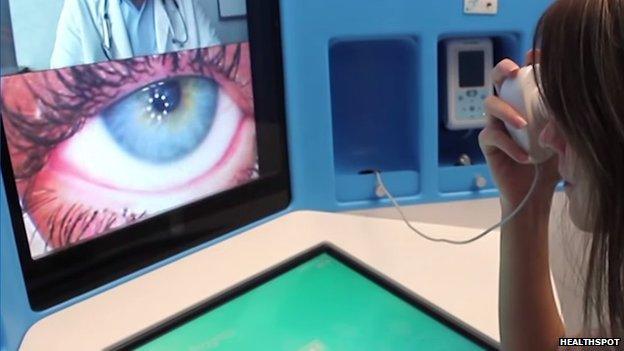
Health monitoring devices are escaping the confines of GPs' surgeries, clinics and hospitals
There is a pressing need for more sustainable healthcare systems around the world.
The costs of providing health services to ageing populations in developed economies are spiralling out of control, while resource depletion in developing economies is threatening the health of millions.
The global healthcare bill is now thought to top $6.5 trillion (£3.9tn) a year.
A key to more sustainable healthcare is encouraging people to take more control of their own health through the use of mobile and telehealth technologies, many experts and technology companies believe.
Consultancy PwC says, external the European Union (EU) alone could save 99bn euros (£80bn; $135bn) by 2017 if it adopted more mobile health - or "m-health" - solutions.
Efficiency gains from the better use of technology could allow 24 million more patients to be treated with the same number of doctors and healthcare facilities, the report concludes.
And about 93bn euros could be added to the EU's economic output if 18 million people with - or at risk from - chronic disease were helped to extend their working lives, it says.
Self health
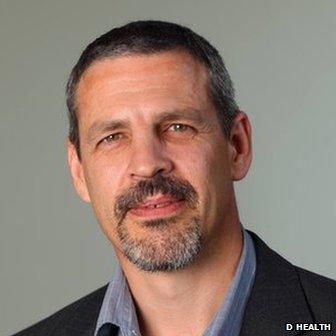
D Health's Steven Dodsworth believes mobile is key to sustainable healthcare
The popularity of smartphones, wearable gadgets and apps that can measure and record exercise levels, heart rate and calories burned, proves that many people are prepared to pay for technology that may benefit their health, says Steven Dodsworth, chief executive of digital healthcare consultancy D Health.
"Rather than producing expensive devices that are used in hospitals, we need technology products that people want, value and can afford," he says.
"They should be sold in consumer electronics shops, High Street pharmacies and supermarkets."
Samsung recently announced its latest wearable prototype health monitor - the Simband - as well as plans to develop a health data sharing platform, and many other technology companies are expanding into this lucrative space.
Informed is forearmed
Mobile gives people access to information they could not easily get before, with all the preventative potential that offers.
For example, in Cameroon, West Africa, half the population lives in rural areas and there is only one doctor for every 5,000 inhabitants.
But when it comes to mobile phones, half the population owns one.
So network operator Orange Cameroon has recently set up, external a text message based teleconsulting service called My Healthline together with the country's Ministry of Health.
This allows phone users to text anonymous questions about health issues, including HIV/AIDS, sexually transmitted diseases and contraception, to Cameroonian doctors and nurses, and to receive a confidential response within an hour.
.jpg)
Information service My Healthline launched in Cameroon earlier this month
There are plenty of other similar m-health examples in developing economies around the world.
Doctor in the booth
Such relatively low-tech solutions can also be complemented by more sophisticated technologies.
For instance, Ohio-based start-up HealthSpot has developed self-contained teleconsulting booths, external that can be installed in office buildings and shopping centres, reducing the need to travel to doctors' surgeries for minor ailments.
HealthSpot's booths are equipped with high definition cameras, microphones and video screens so that patient and doctor can see and talk to each other.
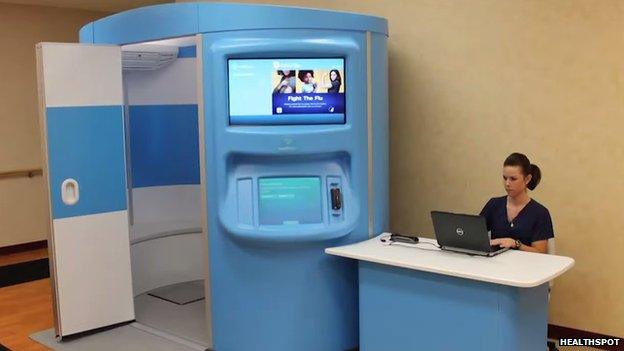
HealthSpot booths are portable and can be installed in community centres, offices or shopping malls
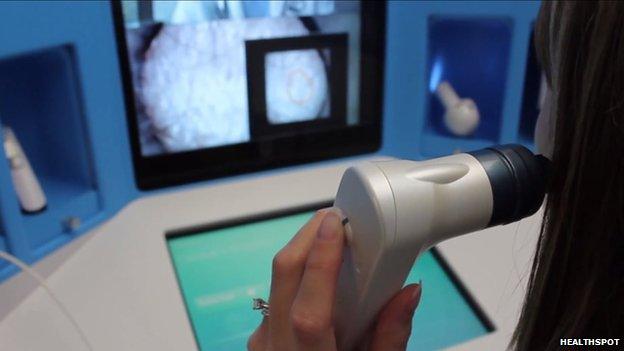
Walk-in patients can use various devices, including an otoscope for examining ears
They also include a range of medical devices such as stethoscopes, thermometers and blood pressure cuffs. Patients can use these devices on themselves by following a doctor's instructions, and data from the devices is streamed to the doctor online.
Prescriptions can be generated and sent electronically to the pharmacy, and the data is integrated securely with local health records.
While the company is primarily rolling out the booths in the US - it recently announced a partnership with Cleveland Clinic, external - it envisages them being installed in communities around the world where local medical services are not available.
Distance healing
One of the main problems with existing health systems is that they were set up to deal with acute cases primarily, yet many people - particularly in ageing populations - suffer from chronic conditions that need more frequent care.
This puts greater stress on GP and hospital resources and leads to many unnecessary visits, with all the associated carbon emissions that entails.
Teleconsultations make obvious sense, therefore.
A study by the Academic Health Science Center in Canada, external found that 840 teleconsultations held over a six-month period resulted in a reduction of 185 tonnes of greenhouse gases, and that took into account the emissions associated with video conferencing energy consumption.
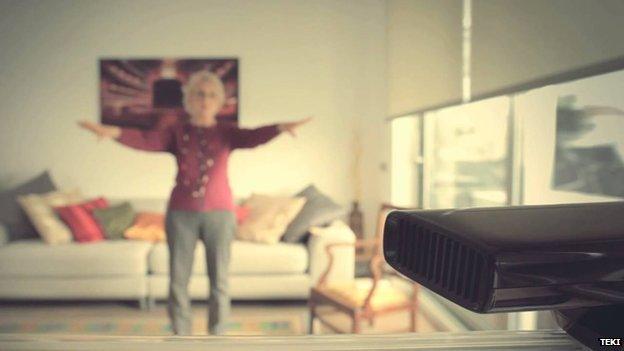
People with chronic conditions can interact with clinicians via a TV equipped with a Microsoft Kinect box
Airedale NHS Foundation Trust in Yorkshire employs a teleconsultation system that uses standard video conferencing equipment to provide health services to 14,500 prison inmates.
The system was originally intended to reduce the costs of escorting prisoners to medical appointments, but it is now used to provide 24-hour consultative care remotely to inmates in 20 prisons.
This system has now been extended to care for chronically ill patients in their own homes or in nursing and residential care homes.
As well as reducing the amount of journeys GPs have to make, it has also led to a 45% drop in hospital admissions from care homes using the system.
Home help
In another example, technology services company Accenture helped set up a telehealth system called Teki in Spain's Basque region.
Patients with chronic diseases, such as arthritis and diabetes, use a Microsoft Xbox game console to see and talk to their doctors and medical staff via their television screens.
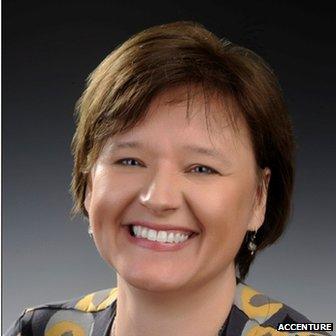
Accenture's Aimie Chapple says giving people care at home is valuable
Patients can follow specific exercise regimes by copying animated avatars on the TV screen. As the Kinect tracks movement, the software can assess whether or not the patient is performing the exercise correctly and give a thumbs up or thumbs down.
Patients can also send real-time diagnostic data using monitoring gadgets that slip easily on to an index finger. The data is encrypted and stored securely at the other end to ensure confidentiality.
"There is something valuable in giving people care in their own homes and avoiding hospitals, especially if their immune system is low," says Aimie Chapple, Accenture's health practice leader.
The implementation of Teki has already saved the region's health authorities more than 40m euros (£33m) as a result of reduced hospital stays, says Accenture.
And by delivering healthcare to chronically ill patients in their own homes this way, the NHS could save up to £7bn a year, the company believes.
"There is certainly evidence of both health and financial benefits," she says.
'Promoting wellbeing'
Health is closely related to wellbeing, and technology can play a part here, too, believes D Health's Steven Dodsworth.
"Housing associations could offer an app that allows isolated people to press a button when they need their grass cutting or their shopping bringing in," he says.
"That could connect to people looking for work, and you then build a community around an isolated person. That promotes wellbeing, allows them to stay in their home longer, and delivers a social benefit, with simple technology as the enabler."
He says that state-funded providers are being far too slow to adopt new technologies, making it hard to prove the benefits on a large scale.
A sustainable health revolution is only likely to happen if technology companies start targeting their products directly at us, the end users, rather than the service providers, he argues.